文化遗产保护-S
- 格式:ppt
- 大小:518.50 KB
- 文档页数:135
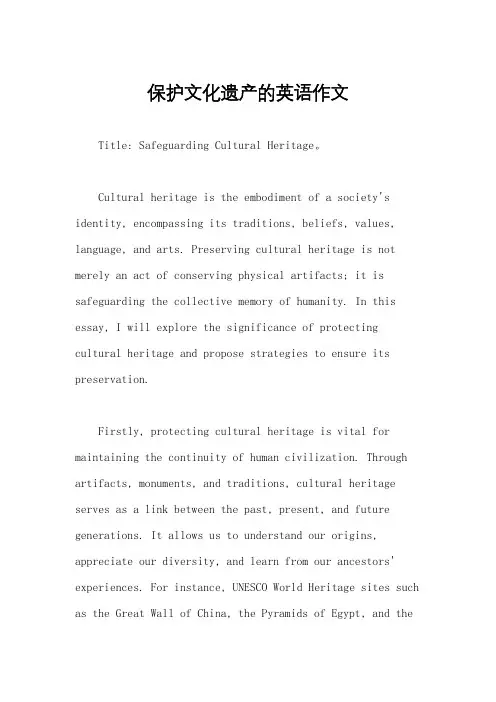
保护文化遗产的英语作文Title: Safeguarding Cultural Heritage。
Cultural heritage is the embodiment of a society's identity, encompassing its traditions, beliefs, values, language, and arts. Preserving cultural heritage is not merely an act of conserving physical artifacts; it is safeguarding the collective memory of humanity. In this essay, I will explore the significance of protecting cultural heritage and propose strategies to ensure its preservation.Firstly, protecting cultural heritage is vital for maintaining the continuity of human civilization. Through artifacts, monuments, and traditions, cultural heritage serves as a link between the past, present, and future generations. It allows us to understand our origins, appreciate our diversity, and learn from our ancestors' experiences. For instance, UNESCO World Heritage sites such as the Great Wall of China, the Pyramids of Egypt, and theAcropolis in Greece not only symbolize human achievementbut also serve as educational resources for future generations.Moreover, cultural heritage plays a crucial role in fostering social cohesion and promoting cultural diversity. It serves as a source of pride and identity for communities, helping them connect with their roots and strengthen bonds among members. By preserving cultural heritage, wecelebrate the richness of human creativity and promote mutual respect and understanding among different cultures. This, in turn, contributes to the promotion of peace and harmony in a globalized world.However, cultural heritage faces numerous threats inthe modern era. Urbanization, industrialization, armed conflict, natural disasters, and illicit trafficking pose significant risks to cultural artifacts and sites. Climate change, in particular, has emerged as a pressing concern, leading to the deterioration of heritage structures and landscapes. Additionally, rapid technological advancements have facilitated the spread of cultural appropriation andthe commodification of cultural symbols, undermining their authenticity and significance.To address these challenges, concerted efforts are needed at local, national, and international levels. Governments, civil society organizations, and the private sector must collaborate to develop comprehensive strategies for the protection and promotion of cultural heritage. These strategies should encompass legislative measures, funding mechanisms, capacity-building initiatives, and community engagement programs.Legislation plays a crucial role in safeguarding cultural heritage by establishing legal frameworks for its protection and regulation. Governments should enact laws to prevent the illegal excavation, trafficking, and export of cultural artifacts, as well as to punish perpetrators of cultural heritage crimes. International conventions, such as the UNESCO World Heritage Convention and the Hague Convention for the Protection of Cultural Property in the Event of Armed Conflict, provide important frameworks for cooperation and coordination among countries.Furthermore, financial resources are essential for the conservation and restoration of cultural heritage. Governments should allocate sufficient funding for heritage preservation projects, including the maintenance ofhistoric sites, the training of heritage professionals, and the implementation of public awareness campaigns. Inaddition to public funding, private sector partnerships, philanthropic initiatives, and crowdfunding platforms can mobilize resources for heritage conservation efforts.Capacity building is another critical component of cultural heritage preservation. Training programs should be organized to equip heritage professionals, conservationists, archaeologists, and museum curators with the necessaryskills and knowledge to safeguard cultural artifacts and sites effectively. Community engagement is also vital for ensuring the sustainable management of cultural heritage,as local communities often have intimate knowledge of their heritage and can actively participate in its preservation.In conclusion, protecting cultural heritage isimperative for safeguarding our shared humanity and promoting sustainable development. By preserving cultural artifacts, traditions, and landscapes, we honor the achievements of past civilizations and enrich the lives of future generations. Through legislative measures, financial support, capacity-building initiatives, and community involvement, we can ensure that cultural heritage remains a source of inspiration, education, and unity for all humankind.。
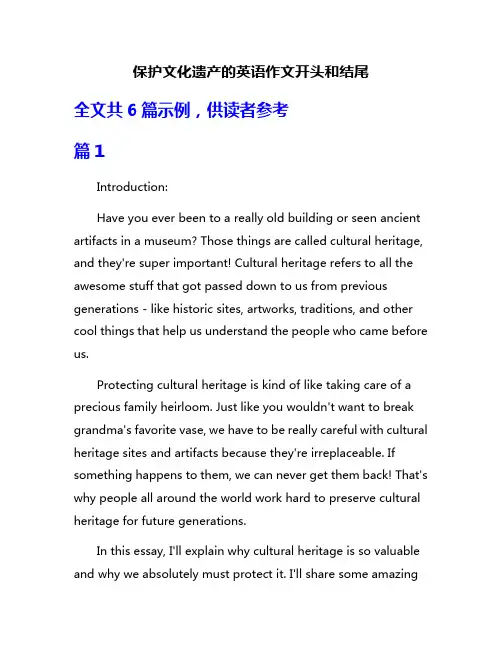
保护文化遗产的英语作文开头和结尾全文共6篇示例,供读者参考篇1Introduction:Have you ever been to a really old building or seen ancient artifacts in a museum? Those things are called cultural heritage, and they're super important! Cultural heritage refers to all the awesome stuff that got passed down to us from previous generations - like historic sites, artworks, traditions, and other cool things that help us understand the people who came before us.Protecting cultural heritage is kind of like taking care of a precious family heirloom. Just like you wouldn't want to break grandma's favorite vase, we have to be really careful with cultural heritage sites and artifacts because they're irreplaceable. If something happens to them, we can never get them back! That's why people all around the world work hard to preserve cultural heritage for future generations.In this essay, I'll explain why cultural heritage is so valuable and why we absolutely must protect it. I'll share some amazingexamples of cultural heritage from different parts of the world. You'll learn about the dangers cultural heritage faces and what people are doing to keep it safe. It's a huge responsibility, but by working together we can make sure our cultural heritage sticks around for a very long time!Conclusion:Well, there you have it - now you know just how important cultural heritage is and why we have to do everything we can to protect it. From ancient ruins to beautiful artwork, cultural heritage gives us an amazing window into the past. It helps us understand where we came from and how people used to live a really long time ago.Unfortunately, cultural heritage is always at risk from threats like war, natural disasters, pollution, theft, and just regular old wear and tear. Countless irreplaceable artifacts and sites have already been damaged or destroyed forever. That's why museums, historians, archaeologists, governments, and people all over the world work so hard to preserve what's left for future generations.Protecting cultural heritage is a huge job, but it's one we all need to pitch in on. We can support museums, be respectful at heritage sites, learn about conservation efforts, and spreadawareness about why this is so crucial. If we work together and do our part, today's kids and grandkids will be able to experience and learn from cultural heritage for centuries to come.Our world's cultures are amazing and irreplaceable. From our oldest traditions to our newest innovations, they all deserve to be celebrated and protected. After all, cultural heritage doesn't belong to any one group - it belongs to all of humanity. Let's work hard to be good stewards and make sure it sticks around forever!篇2Introduction:Hi there! My name is Emma, and I'm a 10-year-old girl who loves learning about different cultures and their histories. You see, I believe that every culture has something special and unique to offer, and it's our responsibility to protect and preserve these cultural treasures for future generations.Cultural heritage is like a beautiful tapestry woven with threads of stories, traditions, and memories passed down from our ancestors. It's a window into the past that allows us to understand where we came from and appreciate the rich diversity of our world. Unfortunately, many cultural heritage sitesand artifacts are at risk of being lost forever due to factors like natural disasters, war, and neglect.Body Paragraphs:One of the most important cultural heritage sites I've learned about is the Great Pyramids of Giza in Egypt. These massive structures were built over 4,500 years ago and are considered one of the Seven Wonders of the Ancient World. Can you imagine the incredible effort and skill it took to construct something so massive without modern tools and technology? The pyramids are a testament to the ingenuity and determination of the ancient Egyptians, and they continue to fascinate people from all over the world.Another cultural heritage site that amazes me is the Taj Mahal in India. This stunning marble mausoleum was built in the 17th century by the Mughal emperor Shah Jahan as a monument of love for his late wife, Mumtaz Mahal. The intricate carvings, calligraphy, and beautiful gardens surrounding the Taj Mahal make it a true masterpiece of Islamic architecture and a symbol of enduring love. Imagine how heartbroken we would be if this incredible structure was lost or damaged beyond repair.Cultural heritage isn't just about grand monuments and ancient ruins, though. It also encompasses the rich traditions,customs, and art forms that have been passed down through generations. For example, the intricate art of origami, or paper folding, has been a beloved tradition in Japan for centuries. Origami is more than just a fun activity; it's a way to express creativity, patience, and attention to detail – values that are deeply ingrained in Japanese culture.Similarly, the vibrant and colorful art of Mexican folk dancing celebrates the country's diverse indigenous roots and reflects the resilience and joy of the Mexican people. Imagine a world where these beautiful art forms no longer existed – it would be like losing a piece of our shared human experience.Conclusion:Protecting cultural heritage is not just about preserving old buildings and artifacts; it's about safeguarding the stories, traditions, and values that have shaped our world and made it the rich tapestry it is today. By learning about and appreciating different cultures, we can foster understanding, respect, and unity among people from all walks of life.So, let's all do our part to protect and celebrate cultural heritage, whether it's by visiting museums, supporting preservation efforts, or simply taking the time to learn about the diverse cultures that exist in our communities and around theworld. After all, cultural heritage is our shared legacy, and it's up to us to ensure that it continues to inspire and enrich future generations.篇3Protecting Our Cultural TreasuresIntroductionHave you ever visited an ancient temple or historic site and felt a sense of wonder at how old it is? I sure have! Places like the Pyramids of Giza, the Colosseum in Rome, and the Forbidden City in Beijing are not just piles of rocks and bricks. They are living connections to the people who lived long ago, reminding us of their stories, cultures, and ways of life.But these incredible cultural treasures are fragile and under threat. From pollution, war, neglect, and thoughtless visitors, our heritage sites are being damaged and even destroyed. It's up to all of us to be their protectors so they can be enjoyed by kids today and for many generations to come. Let me tell you why preserving our cultural heritage is so important!Body ParagraphsFirst off, our heritage sites are like Giant History Books that teach us about the past in a way reading alone can't. Walking through ancient ruins or looking at artifacts in a museum makes history feel real and alive. You can imagine what life was like back then in a way you just can't by reading a textbook. They inspire us to learn more about the amazing cultures that came before us.Plus, many ancient structures and artworks are incredible feats of engineering and craftsmanship, especially when you consider they were built with only basic tools and manpower. The Roman aqueducts, Incan roads through the Andes, and the Islamic tilework of the Blue Mosque showcase human ingenuity and determination. Preserving them honors the knowledge and skills of our ancestors.Our heritage is the story of humanity - the places where pivotal events and world-changing ideas happened. The Parthenon in Athens, the birthplace of democracy. Machu Picchu in Peru, center of the mighty Inca Empire. The Renaissance art and architecture found across Italy. If we let these and other heritage sites crumble into dust and ruin, we lose that visible connection to the people, empires, and movements that shaped our modern world.Not only that, but many cultural sites are sacred places for religious groups and indigenous peoples today. Protecting them preserves their spiritual practices, identities, and ways of life that are deeply rooted in those locations. When heritage sites are ruined, it's a loss for human cultural diversity.Finally, heritage tourism is a huge part of many countries' economies. Millions of visitors flock every year to places like the Taj Mahal, the Pyramids of Giza, and Angkor Wat. If these iconic landmarks were damaged or destroyed, it would hurt jobs and businesses that rely on tourist money. Preserving them preserves people's livelihoods.ConclusionIn conclusion, our world's cultural heritage tells the story of humanity through priceless artifacts, architecture, and places. Not only are they links to our shared past, but they showcase human creativity, ingenuity, and diversity. They also provide economic benefits through tourism.Protecting these treasures is a sacred duty for all people. We must cherish them, learn from them, and pass them safely onward to future kids like you and me. If we fail to be good caretakers of our heritage, we risk losing the pages that tell thetale of human civilization itself. And that would be a tragedy for us all.So be a Heritage Protector! When you visit historic and cultural sites, follow the rules, don't litter or damage anything, and encourage others to respect these special places too. Our ancestors took great pains to create these lasting landmarks. It's up to us to ensure they truly do last forever.篇4Protecting Our Cultural TreasuresHi there! My name is Jamie and I'm a 10-year-old student. Today I want to talk to you about something really important - protecting cultural heritage sites and artifacts around the world. These are precious pieces of history that tell us about how people lived long ago. If we don't take care of them, they could be lost forever!You might be wondering what exactly cultural heritage is. Well, it includes things like ancient ruins, historic buildings, artwork, artifacts dug up from archaeological sites, and even traditions passed down for generations. Anything that helps us understand the culture and way of life of people from the past counts as cultural heritage.Some incredible examples are the Egyptian pyramids, the Colosseum in Rome, the Parthenon in Greece, and the Inca ruins at Machu Picchu. But cultural heritage isn't just about famous sites. It can be a historic house in your own town, indigenous art and crafts, or traditional dances and music. No matter how big or small, it's all important!Unfortunately, many cultural heritage treasures around the world are in danger. They can be damaged by things like weather, pollution, tourism, war, and people being careless or destructive on purpose. Once they're gone, we can never get those pieces of history back. It would be like tearing pages out of a book about our past! That's why we need to protect them.One big threat is tourism. While it's great that so many people want to experience these amazing sites, we have to be really careful. Too many visitors can wear down ancient structures and landscapes over time. That's why rules like staying on marked trails and not touching artifacts are so important to follow.Natural disasters like earthquakes, floods, and fires are another major risk. The incredible Buddhist statues carved into cliffs in Afghanistan were badly damaged by bombing during war. In Iraq, the extremist group ISIS intentionally destroyedpriceless artifacts and archeological sites. This senseless destruction is heartbreaking.Climate change is also putting many cultural heritage sites in jeopardy. Rising sea levels could submerge coastal archaeological sites. Severe drought is cracking and eroding structures like the Mosque of Cristo Rey in Mexico. We have to take action on climate change to protect these irreplaceable treasures.So what can we do to help? Well, for starters, we can treat cultural heritage sites with respect when we visit them as tourists. That means strictly following all the rules to avoid causing any damage. We can also support organizations that work to preserve cultural heritage through donating or volunteering.In school, we can learn as much as we can about the importance of cultural heritage. Understanding why it matters is the first step to protecting it. Getting excavation experience on a supervised archaeological dig is an amazing way to get hands-on too.We can also push our government leaders to provide more funding and stricter laws to safeguard cultural heritage. Having a cultural heritage preservation plan is crucial. With propermanagement and resources, we can conserve these precious pieces of our shared human story.At home, we can explore our own local cultural heritage. Checking out historic neighborhoods, monuments, museums, and cultural festivals is a fun way to learn. Maybe you have family traditions, heirlooms, or stories from grandparents that represent your cultural heritage. Keeping those alive is so meaningful.I hope I've helped explain why protecting cultural heritage is so vital. It allows us to connect to our roots and appreciate the journey of human civilization. Cultural heritage isn't just about old buildings and artifacts - it's about understanding where we all came from. It's like peeking through a window to the past.If we let cultural heritage sites and treasures be destroyed, it would be like shutting that window forever. We'd be cutting ourselves off from such a rich, fascinating history that has so much to teach us. Every ruin, every artwork, every tradition is an important chapter in the story of humanity that we need to keep safe.So let's work together to preserve the world's cultural heritage! Let's treat it with the care and respect it deserves. That way, we can keep learning from the past and ensure futuregenerations can experience it too. We're all part of the human story - let's not let those pages be lost.篇5Protecting Our Cultural TreasuresIntroduction:Have you ever visited an ancient temple or historic site and felt a sense of wonder at how old it was? Places like the Great Pyramids, the Taj Mahal, and the Forbidden City are amazing reminders of the incredible cultures and civilizations that came before us. But did you know that many of these precious cultural heritage sites are in danger? It's up to all of us to help protect them so future generations can experience their beauty and learn from them too.Body Paragraphs:世界上有许多不同的文化,每一种文化都有自己独特的历史、艺术、语言和传统。
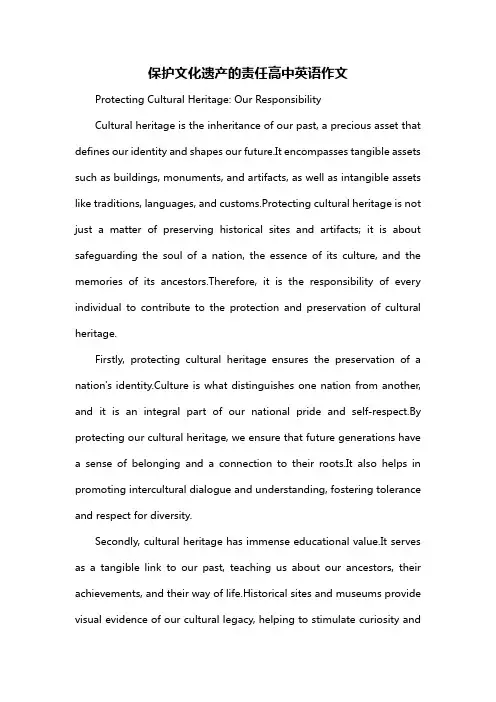
保护文化遗产的责任高中英语作文Protecting Cultural Heritage: Our ResponsibilityCultural heritage is the inheritance of our past, a precious asset that defines our identity and shapes our future.It encompasses tangible assets such as buildings, monuments, and artifacts, as well as intangible assets like traditions, languages, and customs.Protecting cultural heritage is not just a matter of preserving historical sites and artifacts; it is about safeguarding the soul of a nation, the essence of its culture, and the memories of its ancestors.Therefore, it is the responsibility of every individual to contribute to the protection and preservation of cultural heritage.Firstly, protecting cultural heritage ensures the preservation of a nation's identity.Culture is what distinguishes one nation from another, and it is an integral part of our national pride and self-respect.By protecting our cultural heritage, we ensure that future generations have a sense of belonging and a connection to their roots.It also helps in promoting intercultural dialogue and understanding, fostering tolerance and respect for diversity.Secondly, cultural heritage has immense educational value.It serves as a tangible link to our past, teaching us about our ancestors, their achievements, and their way of life.Historical sites and museums provide visual evidence of our cultural legacy, helping to stimulate curiosity andinspire creativity.By studying cultural heritage, students can gain a deeper understanding of history, art, architecture, and literature, among others, enriching their knowledge and broadening their horizons.Moreover, cultural heritage tourism can boost a nation's economy.Historical sites and cultural landmarks attract tourists, generating revenue and creating job opportunities.It also promotes local businesses, such as souvenir shops, restaurants, and hotels.By preserving and promoting cultural heritage, a nation can benefit economically while showcasing its unique culture to the world.However, cultural heritage faces numerous threats, such as urbanization, industrialization, natural disasters, and war.To protect our cultural heritage, we must take collective ernments should establish laws and regulations to preserve historical sites and artifacts, enforce strict guidelines for restoration and development, and provide funding for conservation projects.At the same time, communities and individuals should raise awareness about the importance of cultural heritage and participate in preservation efforts.Volunteer programs, educational workshops, and community involvement can make a significant difference in protecting and promoting cultural heritage.In conclusion, protecting cultural heritage is a shared responsibility that requires the collaboration of governments, communities, and individuals.It is through our collective efforts that we can ensure thepreservation of our cultural legacy for future generations.By valuing and safeguarding our cultural heritage, we contribute to the enrichment of our nation's identity, promote education and understanding, and foster economic growth.Let us fulfill our responsibility by embracing and protecting the invaluable gift of cultural heritage that has been passed down to us.。
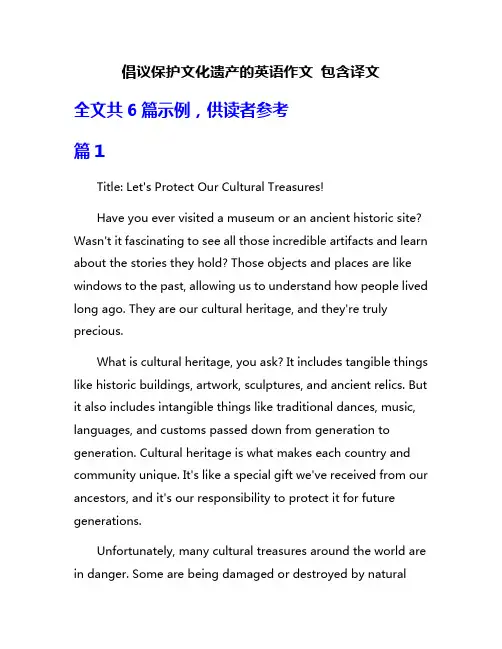
倡议保护文化遗产的英语作文包含译文全文共6篇示例,供读者参考篇1Title: Let's Protect Our Cultural Treasures!Have you ever visited a museum or an ancient historic site? Wasn't it fascinating to see all those incredible artifacts and learn about the stories they hold? Those objects and places are like windows to the past, allowing us to understand how people lived long ago. They are our cultural heritage, and they're truly precious.What is cultural heritage, you ask? It includes tangible things like historic buildings, artwork, sculptures, and ancient relics. But it also includes intangible things like traditional dances, music, languages, and customs passed down from generation to generation. Cultural heritage is what makes each country and community unique. It's like a special gift we've received from our ancestors, and it's our responsibility to protect it for future generations.Unfortunately, many cultural treasures around the world are in danger. Some are being damaged or destroyed by naturaldisasters like earthquakes, floods, and fires. Others are being neglected or forgotten over time. And in some cases, people are deliberately damaging or stealing these precious artifacts for selfish reasons.Imagine if we lost the Great Pyramids of Egypt, the Taj Mahal in India, or the Terracotta Warriors in China! These are priceless pieces of our global heritage that teach us so much about ancient civilizations. We can't let them disappear!But it's not just famous landmarks that matter. Every community has its own unique cultural heritage that deserves to be preserved. It could be an old historic building, a traditional craft, or a special festival celebrated by your ancestors. These things are part of your identity and your roots. Losing them would be like losing a piece of yourself.So, what can we do to protect our cultural heritage? First, we need to learn about and appreciate the treasures we have in our communities and around the world. Visit museums, read books, and talk to elders who can share stories and traditions with you. The more you know, the more you'll care.Next, we need to take good care of our cultural sites and artifacts. That means being respectful visitors, not littering ordamaging these places. We should also support organizations and efforts that work to preserve and restore cultural heritage.Finally, we can spread awareness and encourage others to value and protect our shared heritage. Talk to your friends and family about why it's important. Share information about fascinating cultural treasures on social media. Write letters to your local leaders, asking them to prioritize heritage preservation.Remember, cultural heritage doesn't belong to any one person or group. It belongs to all of humanity. It's our responsibility to cherish and safeguard these treasures for generations to come. By working together, we can ensure that the stories, traditions, and achievements of our ancestors live on, enriching our lives and teaching us valuable lessons about our past.So let's be cultural heritage heroes! Let's explore, appreciate, and protect the amazing cultural treasures around us. They are priceless gifts that connect us to our roots and to each other. Let's make sure they remain for our children, grandchildren, and beyond!Chinese Translation:标题:让我们保护文化遗产!你有没有参观过博物馆或古老的历史遗址?看到那些令人难以置信的文物,了解它们背后的故事,是不是很令人着迷?这些物品和场所就像是通往过去的窗口,让我们了解人们过去的生活方式。
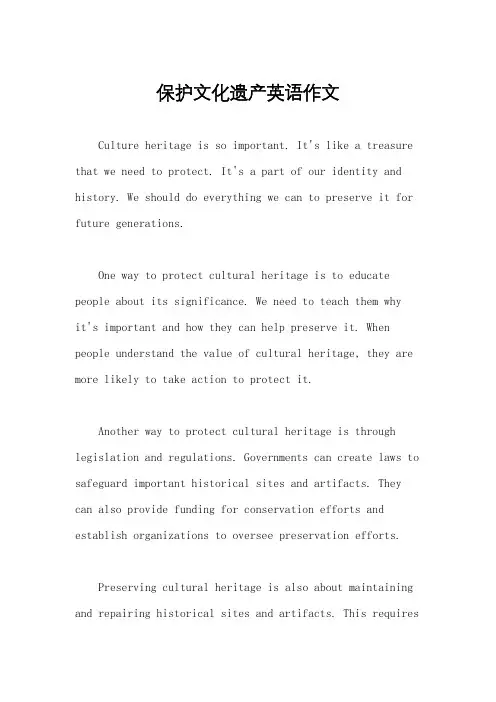
保护文化遗产英语作文Culture heritage is so important. It's like a treasure that we need to protect. It's a part of our identity and history. We should do everything we can to preserve it for future generations.One way to protect cultural heritage is to educate people about its significance. We need to teach them whyit's important and how they can help preserve it. When people understand the value of cultural heritage, they are more likely to take action to protect it.Another way to protect cultural heritage is through legislation and regulations. Governments can create laws to safeguard important historical sites and artifacts. They can also provide funding for conservation efforts and establish organizations to oversee preservation efforts.Preserving cultural heritage is also about maintaining and repairing historical sites and artifacts. This requiresspecialized knowledge and skills. We need experts in conservation and restoration to ensure that our cultural heritage remains intact for future generations to enjoy.Community involvement is crucial for protectingcultural heritage. When local communities are invested in preserving their own history and traditions, they are more likely to take an active role in conservation efforts. This can involve everything from organizing clean-up events to fundraising for preservation projects.In addition to physical preservation, it's important to document and record cultural heritage. This can include everything from collecting oral histories to digitizing important documents and artifacts. By creating a comprehensive record of our cultural heritage, we can ensure that it is not lost to future generations.Ultimately, protecting cultural heritage is acollective responsibility. It requires the efforts of individuals, communities, governments, and organizations.By working together, we can ensure that our cultural heritage remains a vibrant and integral part of our lives.。
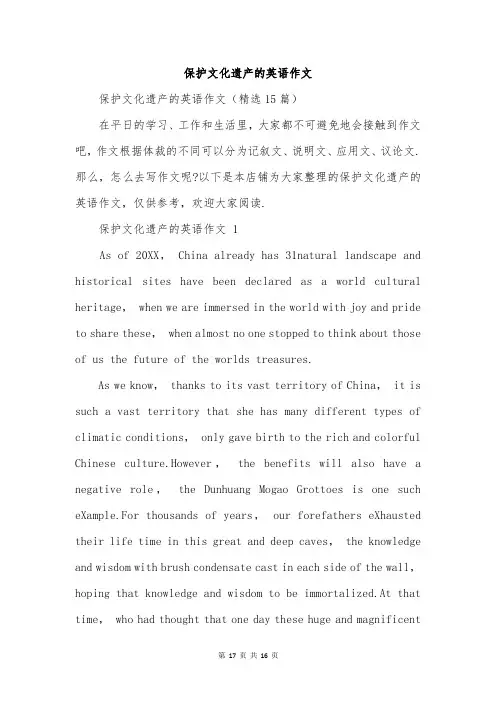
保护文化遗产的英语作文保护文化遗产的英语作文(精选15篇)在平日的学习、工作和生活里,大家都不可避免地会接触到作文吧,作文根据体裁的不同可以分为记叙文、说明文、应用文、议论文.那么,怎么去写作文呢?以下是本店铺为大家整理的保护文化遗产的英语作文,仅供参考,欢迎大家阅读.保护文化遗产的英语作文 1As of 20XX, China already has 31natural landscape and historical sites have been declared as a world cultural heritage, when we are immersed in the world with joy and pride to share these, when almost no one stopped to think about those of us the future of the worlds treasures.As we know, thanks to its vast territory of China, it is such a vast territory that she has many different types of climatic conditions, only gave birth to the rich and colorful Chinese culture.However,the benefits will also have a negative role,the Dunhuang Mogao Grottoes is one such eXample.For thousands of years, our forefathers eXhausted their life time in this great and deep caves, the knowledge and wisdom with brush condensate cast in each side of the wall,hoping that knowledge and wisdom to be immortalized.At that time, who had thought that one day these huge and magnificentworks will be damage to the forces of nature.Mogao Grottoes is located in Chinas north-west,to connect the Eurasian continent in the Silk Road Trail, is a long road that the largest treasure.Despite a hundred years ago it had been stolen,but it damaged the biggest reason is that continental climate brought about by the disaster.Mongolia by the North to the high-pressure effects of climate Dunhuang region perennial drought, sandstorms frequent, annual precipitation is only more than 40 millimeters, while the annual evaporation is as high as more than 4.3thousand millimeters, up to several thousand years of time, our Mogao Grottoes has been frequently attacked by the dust storms, coupled with long-term droughts,earthquakes and rain erosion of the outer wall of a cave once eroded, constantly thinning.To make matters worse, cave murals have begun to change color, from A, crisp and even off base.From the 20th century, the beginning of the 40s, the Chinese people began to have a conscious act together to protect our great historical treasures.First, people have been built in the cliff face sand wall, but have little effect; later tried to dig anti-Shagou, soon to be filled sand.In recent years,we finally found the sand and sand control can be a goodway.First of all, we in the sand and grass, the grass all the sand boX can firmly fiXed in place, after two kilometers to create a shelter belts, so that the effective regulation of regional climate.Scientists said that in this way can prevent nearly 80% of the sand into the Mogao internal.In the protection of our precious world cultural heritage,we really made some encouraging progress, but it should not only be a temporary rescue works.These factors brought about by natural hazards, will no doubt continue, threats still eXist for the Mogao Grottoes, for which efforts also need to last forever, generation after generation.Dear friends, let us join hands together to protect our splendid ancient civilization.We may also slightly younger,but as long as we have a firm belief,jewels will shine forever.Our spirit will spread from one person to another person保护文化遗产的英语作文 2Like tangible cultural heritages such as the Great Wall and the Forbidden City, intangible cultural heritages like Peking Opera and Confucius-commemorating rituals are equally crucial.We should make our utmost efforts to preserve intangible heritages because, without their physical form ofeXistence, they are in greater risk of eXtinction.According to UNESCOs Convention for the Safeguarding of Intangible Cultural Heritage , all forms of social customs and habits, folklore, performing arts, rituals, oral traditions,festivals,traditional crafts and various knowledge and practices about nature and universe can be classified as intangible cultural heritages.As a country consisting of a great diversity of ethnic groups and with time-honored history and civilization,China abounds in intangible cultural heritages.Cultural heritages connect modern people with the historical past, allowing them to acquire a cultural and historical identity.Without cultural heritages, we would be rendered absolutely rootless and we would find it hard to cope with challenges at present and in the future.However, the modernization process poses mounting threats to intangible heritages.Many people have a blind faith in the latest electronic devices.It is also pathetic to see elderly people in possession of such legacies pass away without transmitting them to the younger generation.Faced with those challenges, we should both preserve and renovate our ancestral heritages so that we can help contribute to the cultural diversity of the world and return to our spiritual homeland inthis age of impersonal science and technology.保护文化遗产的英语作文 3Nowadays, Hollywood movies dominate the market and many young people take these superheroes characters as their idols.So some people start to feel disappointed about the local culture, because they havent seen its essence.As the world gets globalization, it is in need of building peoples sense of local cultural heritage.The preservation of our cultural heritage is the necessary task.The culture contains the essence of Chinese peoples spirit,which has been tested by time.When people admit our culture,we will be proud of being part of the country, so as to enhance the unity and have the desire to make a contribution to the society.The loss of cultural heritage will destroy a country,which can be seen in history.As the young generation faces the cultural shock in the globalization, so they are easy to deny the local culture,because they know little about it.Thus school should implant the education of culture and the government has named a day called Chinese Cultural Heritage Day,in the purpose of advocating the essence of local culture.When children grow up,they will fight for protecting the culture.保护文化遗产的英语作文 4Protecting the Intangible Cultural Heritages Like tangible cultural heritages such as the Great Wall and the Forbidden City,intangible cultural heritages like Peking Opera and Confucius-commemorating rituals are equally crucial.We should make our utmost efforts to preserve intangible heritages because, without their physical form of eXistence, they are in greater risk of eXtinction.According to UNESCOs Convention for the Safeguarding of Intangible Cultural Heritage , all forms of social customs and habits, folklore, performing arts, rituals, oral traditions,festivals,traditional crafts and various knowledge and practices about nature and universe can be classified as intangible cultural heritages.As a country consisting of a great diversity of ethnic groups and with time-honored history and civilization,China abounds in intangible cultural heritages.Cultural heritages connect modern people with the historical past, allowing them to acquire a cultural and historical identity.Without cultural heritages, we would be rendered absolutely rootless and we would find it hard to cope with challenges at present and in the future.保护文化遗产的英语作文 5In recent years,there are more and more Confucius Institutes being built all around the world, which shows that our Chinese culture become much more popular than ever.As one of the four ancient civilizations, China has long history and creates many splendid cultures.The ancient culture once had great influence on the world, such as Japan, South Korea and other Asian and European countries.From the respect of school, Confucianism, Mohism, Taoism,and Legalism are the main schools created in ancient China,and they also have great influence on the Modern China and the world,especially the Confucianism.They deeply root in traditional Chinese culture and people’s daily lives.Specially, kung fu, traditional Chinese painting, poem,opera, cooking, clothing, architecture and many other kinds of cultural forms make up the splendid Chinese culture.The kinds listed above are the typical ones which connect to each other at the same time.For eXample, painting, clothing and architecture has many things in common.And each kind of cultural form contains numerous intentions.In short, Chinese culture are the accumulation of Chinese history,which makes Chinese culture colorful and prosperous.If one wants to know or study Chinese culture deeply,he or she must spend much time in it, otherwise he or she can only get the tip of an iceberg.保护文化遗产的英语作文 6Too few people to pay attention to Chinas culture.Urban cultural heritage is the witness of the historical development of the city is the city an important basis for historical research.Sustainable development an important aspect is to protect the historical and cultural heritage.We can adopt the following methods of protection, the entire society to let people know the significance of cultural heritage protection,the enhancement of peoples protection.And then some sites do not open to the public, to a fine of spoilers, the last teacher education allows students to awareness of the importance of the protection of cultural sites.保护文化遗产的英语作文 7Protect Non-Material Cultural Heritage As we all know,non-material culture heritage, also called intangible culture,plays an important role in maintaining the continuity of the nations civilization and sustainable development.But due to the development of globalization and other reasons, more and more non-material culture heritage are on the verge of distinction.So its protection has become an urgent andimportant task at present.What is non-material culture heritage eXactly?It refers to various manifestations of traditional culture handed down from generation to generation and closely related to peoples life, including various practices ,performances,festivals, traditional knowledge and skills, the related instruments,artifacts and culture places.For eXample,paper-cutting and Dragon Boat Festival have been regarded as non-material culture heritage not only by our country but also by the United Nations.Then how can we protect the intangible culture? First of all, we can introduce special programs and columns on TV or in the newspapers and magazines to arouse peoples awareness of its preservation.Second, we should have a rational attitude towards the acceptance of foreign st but not least, we can enforce laws to intensify the protection of non-material culture heritage.保护文化遗产的英语作文 8More and more poeple have culturan heritage protection consciousness,This is a kind of popular trend of modern society.Indeed,people has taken a cultural heritage protection act.We should feel happy, because such behavior will bring us a lot of benefits.First, people will learn incultural heritage of a nations history and culture, which will promote the development of culture.Secondly, many cultural heritage is an important part of the beautiful scenery, this would attract many tourists to visit, which will give nearby residents and government brings income increase, so, peoples living standards will be improved Anyhow, the cultural heritage protection is a meaningful thing,we will continue to work hard to do so.First, we will continue to strengthen cultural heritage protection consciousness, in addition, each of us should put the cultural heritage protection as their own responsibility,when saw sabotage cultural heritage, we should not hesitate to stop保护文化遗产的英语作文 9Cultural heritage is a very important resource.It is an awareness of ancient civilizations important way to study an important resource for human civilization.Cultural heritage is an important indicator of national development is the distinction between national or regional differences in other important reference.Animal or plant can study the remains and other heritage of the history of the human body structure and better understandtheir own.With regard to natural heritage allows us to recognize the difference between the present and ancient times,recognizing that they have on this environment on this planet caused much destruction,called on people to protect the earth.Of course,there are ancient buildings,etc.,let us insight into the unsurpassed wisdom of our ancestors,to succeed in life!In short,the cultural heritage of human development has an indelible impact,we should protect the cultural heritage,and actively repair the damaged heritage of human civilization and contribute to the development.保护文化遗产的英语作文 10In recent years,there are more and more Confucius Institutes being built all around the world, which shows that our Chinese culture become much more popular than ever.As one of the four ancient civilizations, China has long history and creates many splendid cultures.The ancient culture once had great influence on the world, such as Japan, South Korea and other Asian and European countries.From the respect of school,Confucianism, Mohism, Taoism, and Legalism are the main schools created in ancient China, and they also have great influence on the Modern China and the world, especially theConfucianism.They deeply root in traditional Chinese culture and people’s daily lives.Specially, kung fu, traditional Chinese painting, poem,opera, cooking, clothing, architecture and many other kinds of cultural forms make up the splendid Chinese culture.The kinds listed above are the typical ones which connect to each other at the same time.For eXample, painting, clothing and architecture has many things in common.And each kind of cultural form contains numerous intentions.In short, Chinese culture are the accumulation of Chinese history, which makes Chinese culture colorful and prosperous.If one wants to know or study Chinese culture deeply, he or she must spend much time in it, otherwise he or she can only get the tip of an iceberg.保护文化遗产的英语作文 11Last week, I visited the geological museum with my best friend, Liu was my first time to go there.The moment we arrived there, we found that thebuilding was grand.When we walked into it, there was a big hall in front of then there were several rooms to show different kinds objects.There was aroom for collecting scripts and paintings.There was another room to storeclothes and shoes in the old times.The neXt room was for collecting the dailynecessities in the old days.In a word, allthe things in it had a long history.I learnt some knowledge from it.保护文化遗产的英语作文 12There is no doubt that Hollywood movie is favored by all the people.Almost in every country, Hollywood movies always defeat the local movies, winning the biggest profit.Hollywood movies catch the publics attention by good plots and advanced technology, while the local culture has been face challenge.In the open market, how to preserve and develop the local culture is the biggest problem.For the young generation, they are easy to be caught by the foreign culture, thus to deny the local culture.For some directors, they ask for cooperation with the Hollywood actors,in the hope to develop local movies.But the result always disappoint the audience, they dont pay the bill to see the strange scene.The reason for the loss popularity of local culture lies in its old features.If the culture is presented in the new look,it is much easier for the young generation to accept.Only the creativity can make one thing be popular all the time.In the open market, though the local culture face challenge, it still have its advantage, which is the combination of a nations wisdom.保护文化遗产的英语作文 13The passage mainly tells us the importance of protecting traditional Chinese culture, which is challenged or facing eXtinction because of the developing society and changing lifestyle.Besides, China is nationwide sparing no efforts to do it.The protection of national and folk culture is of great significance to Chinese cultural diversity and also to the harmonious development between local economic and social development.It is reported that the Guangdong government pays special attention to protecting Chaoju(潮剧), a local drama born in Chaozhou in the eastern Guangdong province.In my opinion, some measures should be taken to protect traditional culture effectively.To start with, we should make a law to regulate the society’s performance.Besides, we should draw more people’s attention to it, for the more they know about the importance of culture protection, the stronger the support we can get from the public.In a word, it is high time for us to treasure and develop our own valuable culture.保护文化遗产的英语作文 14Protecting the Intangible Cultural Heritages Like tangiblecultural heritages such as the Great Wall and the Forbidden City,intangible cultural heritages like Peking Opera and Confucius-commemorating rituals are equally crucial.We should make our utmost efforts to preserve intangible heritages because, without their physical form of eXistence, they are in greater risk of eXtinction.According to UNESCOs Convention for the Safeguarding of Intangible Cultural Heritage , all forms of social customs and habits, folklore, performing arts, rituals, oral traditions,festivals,traditional crafts and various knowledge and practices about nature and universe can be classified as intangible cultural heritages.As a country consisting of a great diversity of ethnic groups and with time-honored history and civilization,China abounds in intangible cultural heritages.Cultural heritages connect modern people with the historical past, allowing them to acquire a cultural and historical identity.Without cultural heritages, we would be rendered absolutely rootless and we would find it hard to cope with challenges at present and in the future.保护文化遗产的英语作文 15Since the People’s Republic of China was founded in 1949,the Chinese government has attached great importance todocumenting and protecting the eXcellent traditional ethnic cultures in Xinjiang, and ensuring that they are passed on to succeeding generations.It has promoted creative transformation and innovative development, encouraging these ethnic groups to learn spoken and written languages from each other, promoted communication and integration, respected their freedom of religious belief, and worked to develop their cultural undertakings and industries.The government has worked to modernize ethnic cultures, to strengthen cultural eXchanges with foreign countries, and to enhance each group’s cultural confidence while engaging in eXchanges with and mutual learning from others.。
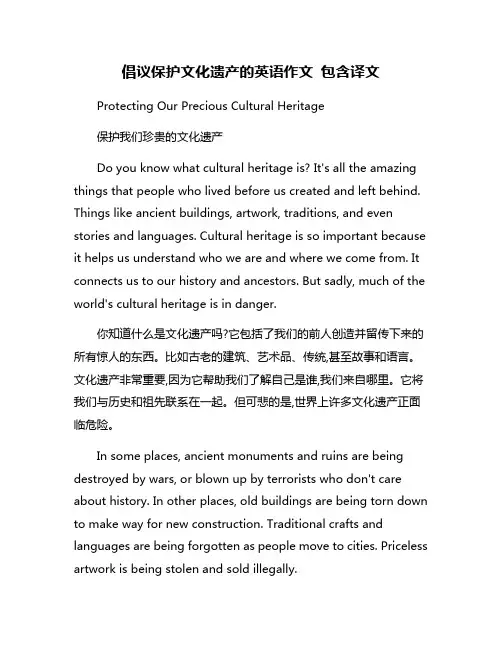
倡议保护文化遗产的英语作文包含译文Protecting Our Precious Cultural Heritage保护我们珍贵的文化遗产Do you know what cultural heritage is? It's all the amazing things that people who lived before us created and left behind. Things like ancient buildings, artwork, traditions, and even stories and languages. Cultural heritage is so important because it helps us understand who we are and where we come from. It connects us to our history and ancestors. But sadly, much of the world's cultural heritage is in danger.你知道什么是文化遗产吗?它包括了我们的前人创造并留传下来的所有惊人的东西。
比如古老的建筑、艺术品、传统,甚至故事和语言。
文化遗产非常重要,因为它帮助我们了解自己是谁,我们来自哪里。
它将我们与历史和祖先联系在一起。
但可悲的是,世界上许多文化遗产正面临危险。
In some places, ancient monuments and ruins are being destroyed by wars, or blown up by terrorists who don't care about history. In other places, old buildings are being torn down to make way for new construction. Traditional crafts and languages are being forgotten as people move to cities. Priceless artwork is being stolen and sold illegally.在一些地方,古老的纪念碑和遗址正遭到战争破坏,或被那些不关心历史的恐怖分子炸毁。
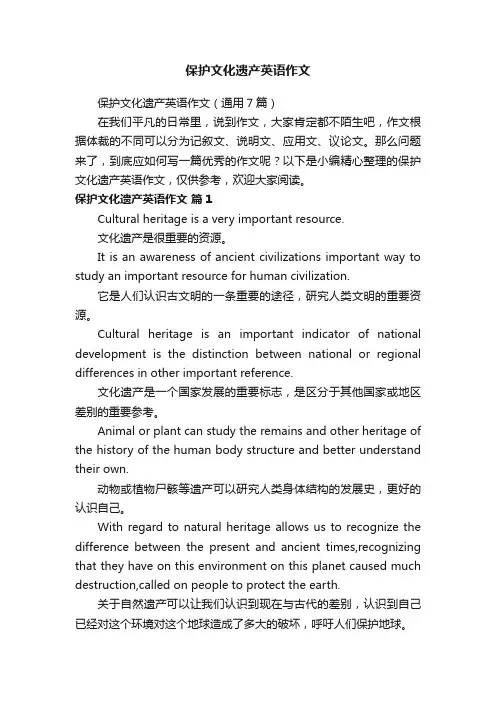
保护文化遗产英语作文保护文化遗产英语作文(通用7篇)在我们平凡的日常里,说到作文,大家肯定都不陌生吧,作文根据体裁的不同可以分为记叙文、说明文、应用文、议论文。
那么问题来了,到底应如何写一篇优秀的作文呢?以下是小编精心整理的保护文化遗产英语作文,仅供参考,欢迎大家阅读。
保护文化遗产英语作文篇1Cultural heritage is a very important resource.文化遗产是很重要的资源。
It is an awareness of ancient civilizations important way to study an important resource for human civilization.它是人们认识古文明的一条重要的途径,研究人类文明的重要资源。
Cultural heritage is an important indicator of national development is the distinction between national or regional differences in other important reference.文化遗产是一个国家发展的重要标志,是区分于其他国家或地区差别的重要参考。
Animal or plant can study the remains and other heritage of the history of the human body structure and better understand their own.动物或植物尸骸等遗产可以研究人类身体结构的发展史,更好的认识自己。
With regard to natural heritage allows us to recognize the difference between the present and ancient times,recognizing that they have on this environment on this planet caused much destruction,called on people to protect the earth.关于自然遗产可以让我们认识到现在与古代的差别,认识到自己已经对这个环境对这个地球造成了多大的破坏,呼吁人们保护地球。
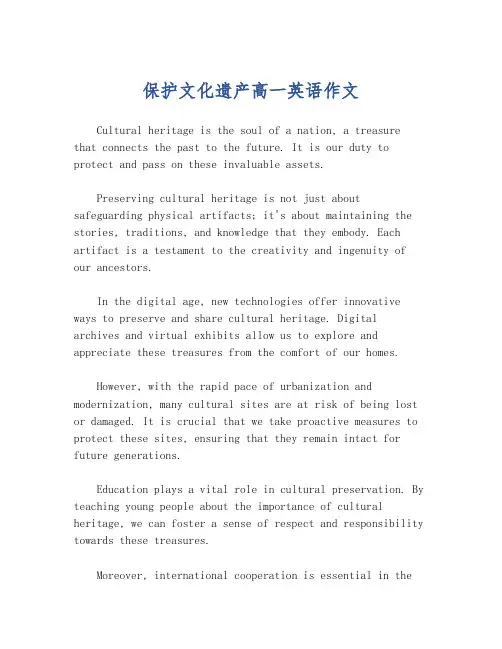
保护文化遗产高一英语作文Cultural heritage is the soul of a nation, a treasurethat connects the past to the future. It is our duty to protect and pass on these invaluable assets.Preserving cultural heritage is not just about safeguarding physical artifacts; it's about maintaining the stories, traditions, and knowledge that they embody. Each artifact is a testament to the creativity and ingenuity of our ancestors.In the digital age, new technologies offer innovative ways to preserve and share cultural heritage. Digital archives and virtual exhibits allow us to explore and appreciate these treasures from the comfort of our homes.However, with the rapid pace of urbanization and modernization, many cultural sites are at risk of being lost or damaged. It is crucial that we take proactive measures to protect these sites, ensuring that they remain intact for future generations.Education plays a vital role in cultural preservation. By teaching young people about the importance of cultural heritage, we can foster a sense of respect and responsibility towards these treasures.Moreover, international cooperation is essential in theprotection of cultural heritage. Many cultural sites are shared between countries and require collaborative efforts to ensure their preservation.In conclusion, protecting cultural heritage is a collective responsibility that transcends borders and generations. It is through our shared efforts that we can ensure the legacy of our ancestors is not only preserved but celebrated and cherished by all.。
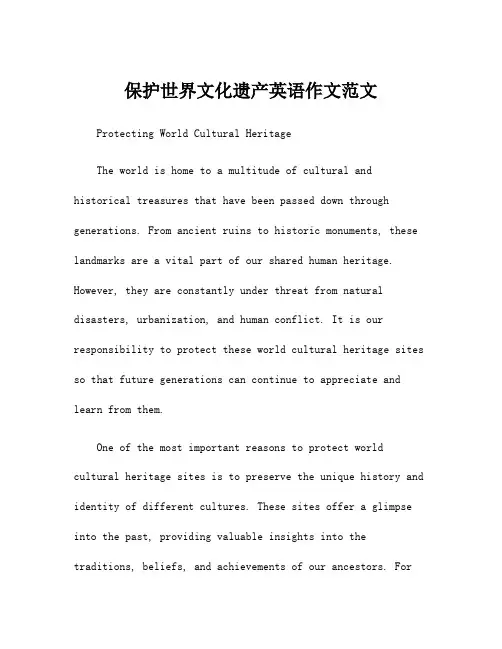
保护世界文化遗产英语作文范文Protecting World Cultural HeritageThe world is home to a multitude of cultural andhistorical treasures that have been passed down through generations. From ancient ruins to historic monuments, these landmarks are a vital part of our shared human heritage. However, they are constantly under threat from natural disasters, urbanization, and human conflict. It is our responsibility to protect these world cultural heritage sites so that future generations can continue to appreciate and learn from them.One of the most important reasons to protect world cultural heritage sites is to preserve the unique history and identity of different cultures. These sites offer a glimpse into the past, providing valuable insights into the traditions, beliefs, and achievements of our ancestors. Forexample, the Great Wall of China stands as a symbol ofancient engineering and a testament to China's rich history. Without these sites, we would lose an important connection to our roots and the diversity of human experience.Furthermore, protecting world cultural heritage siteshelps to foster a sense of pride and belonging within communities. Many of these sites hold significant culturaland religious value for local populations, serving as symbols of their heritage and traditions. By safeguarding these sites, we show respect for the people who hold them dear and ensure that their cultural legacy is not forgotten. In turn, thiscan promote social cohesion and strengthen the bonds between different groups.In addition to their cultural significance, worldheritage sites also contribute to global tourism and economic development. These landmarks draw millions of visitors each year, generating revenue and employment opportunities fornearby communities. This not only benefits the local economy but also raises awareness and appreciation for the importance of preserving these sites. By protecting world cultural heritage, we can continue to reap the economic rewards and inspire future generations to engage with our shared history.Despite their cultural and economic value, many world heritage sites are vulnerable to a range of threats. Environmental factors, such as climate change and natural disasters, pose a significant risk to these landmarks. For example, rising sea levels threaten coastal heritage sites, while extreme weather events can cause damage to ancient structures. Additionally, urbanization and infrastructure development can encroach upon these sites, leading to their destruction or degradation. Furthermore, armed conflict and political instability in certain regions have resulted in deliberate attacks on cultural heritage, leading to irreparable loss.To address these threats, it is critical to implement comprehensive conservation and management strategies for world cultural heritage sites. This includes conducting regular assessments of environmental risks, implementing sustainable tourism practices, and involving local communities in the preservation efforts. Furthermore, international cooperation and support are essential to ensure the protection of these sites, particularly in areas affected by conflict and political instability. By working together, we can establish a unified front against the forces that endanger our shared cultural heritage.Education also plays a crucial role in protecting world cultural heritage. By raising awareness about thesignificance of these sites and their conservation needs, we can encourage a sense of responsibility and stewardship among the public. This can be achieved through school curriculums, public awareness campaigns, and community engagement initiatives. By instilling a sense of pride and ownership inour cultural heritage, we can foster a collective commitment to its preservation.In conclusion, protecting world cultural heritage sites is vital for safeguarding our shared history, promoting cultural diversity, and fostering sustainable development. These sites serve as a testament to human ingenuity, creativity, and resilience, and it is our duty to ensure their preservation for future generations. By addressing the various threats they face and promoting public awareness and involvement, we can work towards a world where our cultural heritage is celebrated, respected, and protected.。

非物质文化遗产SWOT1分析1)优势S:著作权;传统工艺美术;博物馆;文物藏品;中华人民共和国著作权法(1991);中华人民共和国著作权法实施条例(2002)等尽10部法律,对知识产权的保护。
具有xx当特色,流传的传统美术、书法、音乐、传统技艺、传统礼仪、节庆等民俗属于申报范畴。
历史流传久远,群众认可并有一定口碑。
紧跟政策推动西安国际化大都市建设的国家级新区,统筹科技资源的新兴产业积聚,城乡统筹发展的一体化建设示范区。
??文化大省、历史大省历史悠久,xx也能很好体现以上内容。
2)劣势W:具有一定壁垒,需要非遗知识产权不明晰,纠纷较多,通常给界定带来很大难度。
xx当地非物质文化遗产档案不全,传承人较多,导致纠纷、法律等问题,给申报工作带来很多意想不到的难度和困难。
申遗工作开展缓慢,传统艺人对其重视程度不足。
政策宣传力度难保证,申遗工作往往受到群众不理解,误以为自身利益受到侵犯。
申遗工作还需大量整理,调研,走访以及当地政府大量配合。
4)机会O:申遗成功对xx当地知名度有很大提升,带动经济,旅游等产业发展。
深入挖掘、保护和传承当地具有地方特色的文化形态,促进地区民族文化水平升级上档。
对xx当地非物质文化遗产开展产学研的文化类研究,推广更多文化科技成果。
其中重视非遗挖掘工作,可以作为农村统筹规划典范,对全省乃至全国的有推广借鉴及指导意义。
5)威胁T:全省各地申遗工作逐渐增多,申遗的意识强烈,因此竞争也将更加激烈。
申遗工作体系趋于完善,考核标准趋于规范,严谨,其中牵扯到归属权纠纷,产权明晰等法律因素逐渐增多。
申遗内容应该尽早概念化、明确化、规范化,避免在申报工作中难度。
.通过SWOT的分析,得出以下对策:1尽快取得当地文化主管部门重视,加快申遗工作的进度,开展前期调研方案确立。
2积极开展产学研方面的工作,聘请省内专家对非遗工作的论证和调研。
3尽快确立和筛选申遗的内容,要求申遗项目概念明确,具有独立特色,产权明晰,有依可据。
传统节日的物质文化遗产保护与传承(精选)传统节日的物质文化遗产保护与传承传统节日是一个国家或地区的文化瑰宝,是民族精神的重要表现。
传统节日不仅体现了人们对祖先的敬仰和纪念,还承载了丰富的历史文化内涵。
然而,随着现代化的进程和文化的多元化,传统节日的物质文化遗产面临着流失和失传的危机。
因此,保护和传承传统节日的物质文化遗产变得尤为重要。
本文将探讨传统节日的物质文化遗产的重要性,分析其保护与传承的困境,并提出相应的解决方案。
一、传统节日的物质文化遗产的重要性传统节日的物质文化遗产包括了节日的习俗、食物、服装、音乐、舞蹈等方面的内容。
这些物质文化遗产不仅承载了人们对传统文化的情感认同,更是历史和文化传承的重要见证。
例如,中国的春节是中华民族最重要的传统节日,春联、年画、舞龙灯等都是其独特的物质文化遗产。
这些传统节日的物质文化遗产不仅具有观赏价值,还具有寓意、祈福的功能。
保护和传承这些物质文化遗产,不仅能够维护人们对传统节日的认同感,更能够促进国家和地区的文化自信和认同感。
二、传统节日物质文化遗产的保护与传承困境然而,传统节日的物质文化遗产面临着许多挑战。
首先,现代化进程和城市化浪潮下,人们对传统节日的关注度逐渐下降,物质文化遗产的传承形式、传播渠道和受众范围都面临着缩小的趋势。
其次,全球化的影响使得传统节日的物质文化遗产受到了外来文化的冲击,导致一些传统节日的物质文化遗产逐渐淡化或改变。
最后,缺乏相应的保护与传承机制以及专业人才的培养,也给传统节日的物质文化遗产保护与传承带来了困难。
三、保护与传承传统节日物质文化遗产的解决方案为了保护和传承传统节日的物质文化遗产,我们应该采取一系列措施。
首先,加强法律法规的制定和实施,建立完善的保护机制,加大对传统节日物质文化遗产的保护力度。
其次,加强专业人才的培养和传承。
通过设立相关专业学科,培养传统节日物质文化遗产的专业人才,提高他们的保护与传承能力。
同时,加强对民间艺术家和传统手艺人的培养与激励,推动他们传承和创新传统节日物质文化遗产。
保护文化遗产传承中华文明的素材全文共四篇示例,供读者参考第一篇示例:文化遗产是一个民族的灵魂,是历史的见证者,是文明的传承者。
作为中华文明的代表,我们应当倍加珍惜和保护好我们的文化遗产,让它们得以传承和发扬光大。
一、文化遗产的定义文化遗产指的是人类活动在历史长河中留下来的有形和无形的物质和精神财富。
它包括了历史遗迹、古老建筑、传统艺术、民间工艺、口述文学等多个方面。
这些文化遗产既是一种历史的延续,也是一种文明的传承。
保护文化遗产就是要保护我们的历史,传承我们的文明。
保护文化遗产不仅仅是为了保存历史,更重要的是传承文明。
文化遗产是我们的根,是我们的源。
只有保护好我们的文化遗产,我们才能找到自己的文化根脉,才能在现代社会中找到自己的文化自信。
文化遗产也是我们民族的骄傲和自豪。
它们让我们感到自豪和自信,让我们更加热爱我们的国家和文化。
保护文化遗产是保护我们自己的文化身份,是保护我们的文化自信。
四、如何保护文化遗产保护文化遗产需要国家、社会和每个人的共同努力。
国家应当加大对文化遗产的保护力度,加强文化遗产的保护法律法规,建立健全的文化遗产保护机制。
国家应当加大对文化遗产的投入,增加文化遗产的保护和修复工作。
社会应当加强对文化遗产的宣传和教育,增强人们对文化遗产的认识和保护意识。
每个人都应当从自身做起,爱护文化遗产,不随意破坏,积极弘扬传统文化,传承中华文明。
第二篇示例:保护文化遗产传承中华文明中华文明源远流长,拥有丰厚的历史积淀和深厚的文化底蕴。
作为世界上最古老的文明之一,中华文明的传承保护显得尤为重要。
文化遗产是中华文明的重要组成部分,是历史的见证和传承的载体。
保护文化遗产,传承中华文明,不仅是维护国家文化自信和民族精神的需要,也是对历史和传统的尊重和珍惜。
在当今快节奏的社会中,如何保护文化遗产,传承中华文明,成为亟待解决的重要问题。
一、加强文物保护与修复文物是中华文明的珍贵遗产,承载着古代人们的智慧和工艺,是文化传承的重要见证。
保护世界文化遗产英文作文Protecting the World's Cultural Heritage.Cultural heritage is a crucial aspect of human civilization, representing the rich tapestry of our shared past. It encompasses not only the grand monuments and historical sites that dot the globe, but also theintangible cultural practices, traditions, and knowledge systems that have been passed down through generations.This diverse and valuable inheritance is not just a recordof our history; it is a vital link to our identity as a species and a critical component of sustainable development.Unfortunately, the world's cultural heritage is increasingly threatened by a range of factors, including war, natural disasters, neglect, and development pressures. The consequences of these threats are profound, leading to the destruction of irreplaceable historical sites, the erosion of traditional knowledge systems, and the loss of cultural diversity. It is crucial that we take action toprotect and preserve this irreplaceable inheritance for future generations.One of the most effective ways to protect cultural heritage is through international cooperation and the establishment of legal frameworks. The United Nations Educational, Scientific and Cultural Organization (UNESCO) has played a pivotal role in this effort, designing conventions and recommendations that aim to safeguard cultural heritage worldwide. The 1972 Convention Concerning the Protection of the World Cultural and Natural Heritage, in particular, has been instrumental in identifying and protecting sites of outstanding universal value.However, laws and conventions are only as effective as the political will and commitment to implement them. It is essential that governments prioritize cultural heritage protection in their policies and allocate sufficient resources to ensure its safeguarding. This includes investing in conservation efforts, promoting public awareness and education, and fostering partnerships with local communities and stakeholders.Community engagement is also crucial to the protectionof cultural heritage. Local communities often have a deep understanding and connection to their cultural heritage,and they are often the first responders in cases of natural disasters or conflict. By involving them in heritage protection initiatives, we can ensure that their knowledge and expertise are harnessed effectively. Additionally, community engagement can foster a sense of ownership and responsibility among the people, making them more likely to safeguard and promote their cultural heritage.Innovative technologies also offer new opportunitiesfor protecting cultural heritage. Digital preservation techniques, such as 3D scanning and virtual reality, allow us to create digital replicas of cultural sites and objects, ensuring their accessibility even in the event of their physical destruction. Digital technologies can also be used to enhance public engagement and education, making theworld's cultural heritage more accessible and relevant to people of all ages and backgrounds.In conclusion, protecting the world's cultural heritage is a crucial task that requires a concerted effort from governments, communities, and individuals alike. By prioritizing cultural heritage protection, fostering community engagement, and harnessing innovative technologies, we can ensure that the rich and diverse cultural inheritance of human civilization is preserved for future generations. It is only through such collective action that we can safeguard the irreplaceable treasures of our shared past and build a more inclusive and sustainable future.。
Cultural Heritage Protection: A VitalResponsibility for High School StudentsCultural heritage, the embodiment of a nation's history, traditions, and values, is an invaluable asset thatdeserves utmost respect and protection. As high school students, we hold a significant responsibility inpreserving and promoting this rich legacy for future generations. This essay aims to explore the importance of cultural heritage protection, the challenges it faces, and the role of young individuals in safeguarding it.Firstly, cultural heritage is not just about ancient artifacts or historical buildings; it encompasses the diverse traditions, languages, and customs that shape our identity as a society. Preserving this heritage is crucial for maintaining cultural diversity and fostering a sense of belonging and pride among individuals. Cultural heritage also serves as a bridge between the past and the future, connecting us with our ancestors and informing our understanding of our own cultural roots.However, the protection of cultural heritage faces numerous challenges in today's world. Urbanization,industrialization, and globalization have led to the loss of many cultural practices and traditions. The neglect of local customs and the erasure of historical landmarks in the pursuit of modernization pose a serious threat to the survival of cultural heritage. Additionally, the impact of climate change and natural disasters, such as floods and earthquakes, further exacerbate the situation.As high school students, we can play a vital role in addressing these challenges. Firstly, we can raise awareness about the importance of cultural heritage protection among our peers, family, and community. By sharing stories and experiences related to our cultural heritage, we can inspire others to appreciate and value it. We can also participate in local cultural events and festivals, promoting our traditions and customs.Moreover, we can advocate for stronger policies and laws that protect cultural heritage. We can engage with policymakers and urge them to prioritize the preservation of historical landmarks and the promotion of cultural diversity. We can also support organizations that arededicated to heritage conservation, such as museums and cultural centers, by volunteering or fundraising.Furthermore, we can embrace technology as a tool for heritage protection. Digitalization and virtual reality technologies can be used to create digital replicas of historical sites and artifacts, preserving them for future generations. We can also utilize social media platforms to share information about cultural heritage and mobilize support for its protection.In conclusion, cultural heritage protection is acrucial responsibility that high school students must embrace. By raising awareness, advocating for stronger policies, and embracing technology, we can contribute to safeguarding our cultural heritage and ensuring itssurvival for future generations. As young individuals, we have the power to shape the future of our cultural identity and legacy, and it is our duty to do so with utmost care and respect.**文化遗产保护:高中生的重要责任**文化遗产,作为一个国家历史、传统和价值观的体现,是一种无价之宝,值得我们给予最崇高的尊重和保护。
保护文化遗产作文英语Cultural heritage is a precious legacy left by our ancestors, reflecting the history, culture, and spirit of a nation. It is our responsibility to protect and pass on this legacy to future generations.Firstly, protecting cultural heritage helps to preserve the diversity of human civilization. Each culture has its unique value and charm. By protecting cultural heritage, we can better understand and respect different cultures, promoting the exchange and integration of civilizations.Secondly, protecting cultural heritage is conducive to enhancing national cohesion and identity. Cultural heritage is an important symbol of national spirit and identity. It can inspire people's love for their country and nation, strengthening national unity and cohesion.Thirdly, protecting cultural heritage is beneficial for promoting economic development. Cultural heritage is an important resource for tourism. By developing tourism based on cultural heritage, it can drive economic growth and improve people's living standards.However, protecting cultural heritage also faces many challenges. For example, some cultural heritage sites are damaged due to natural disasters or human activities. Therefore, we need to take various measures to protectcultural heritage.First, we should strengthen the legislation and management of cultural heritage. Governments should formulate relevant laws and regulations to protect cultural heritage and crack down on illegal acts.Second, we should enhance public awareness and participation. Through education and publicity, we can raise people's awareness of protecting cultural heritage and encourage them to participate actively.Lastly, we should strengthen international cooperation. Cultural heritage is a common treasure of humanity. We need to strengthen cooperation with other countries to jointly protect cultural heritage.In conclusion, protecting cultural heritage is an important task for all of us. Only by protecting cultural heritage can we better carry forward the excellent traditional culture, promote the exchange and integration of civilizations, and achieve sustainable development of human society.。
保护文化遗产英语作文英文回答:As a cultural heritage enthusiast, I believe that protecting cultural heritage is of utmost importance. Cultural heritage represents the history, traditions, and values of a society, and it is essential to preserve it for future generations. Without protection, cultural heritage can be lost forever, and with it, the identity and pride of a community.One of the reasons why protecting cultural heritage is crucial is that it helps us understand our roots and where we come from. For example, the Great Wall of China is not only a remarkable architectural achievement but also a symbol of China's rich history and cultural identity. It attracts millions of tourists every year, contributing to the country's economy and promoting cultural exchange.Furthermore, protecting cultural heritage can alsofoster a sense of belonging and pride among the local community. When people see their heritage being preserved and celebrated, they are more likely to take pride in their cultural identity and pass it on to future generations. For instance, traditional festivals like the Chinese New Year and the Mid-Autumn Festival are not only important cultural events but also opportunities for families to come together and pass down traditions.In addition, protecting cultural heritage can also stimulate economic growth and development. Historical sites and cultural landmarks often attract tourists, generating revenue for the local economy and creating job opportunities. For example, the preservation of the ancient city of Petra in Jordan has not only maintained its historical significance but also contributed to the growth of the tourism industry in the region.Overall, protecting cultural heritage is essential for preserving our history, promoting cultural identity, and stimulating economic growth. It is our responsibility to safeguard and cherish our cultural heritage for the benefitof present and future generations.中文回答:作为一个文化遗产爱好者,我认为保护文化遗产至关重要。